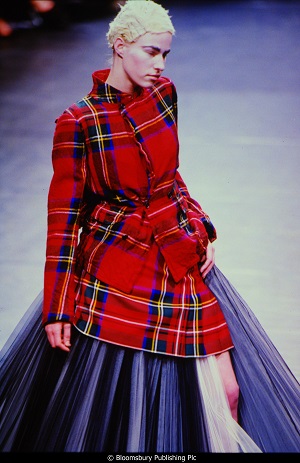Punk: Subculture to Couture
Explore how the punk aesthetic shifted from the sidewalk to the catwalk through our selection of free articles, chapters, images and videos.

Punk
We’re diving into the subculture of punk and its rebellious influence on fashion, tracing its “do-it-yourself” origins, how it was born from societal circumstance, and its reimagining in the 1990s.
This featured content explores trends, influences, and ideologies of this youth subculture, and its continued cultural impact on contemporary fashion.
Explore how the punk aesthetic shifted from the sidewalk to the catwalk through our selection of free articles, chapters, images and videos.
Punk Style and Society
Emerging in 1970-80s London and New York, take a look at how Punk Style and Society was created in response to feelings of resentment towards the political and economic climate. This socio-political crisis prompted a new formation of aesthetics, and was even viewed by some critics as the Postmodernization of Fashion, as it moved young people to rebel in a ‘visually violent response’ to the middle-class infrastructure. Punk style was also supported by the backbone of Punk music; read more in this Punk Encyclopedia entry on how the ‘musical underpinnings’ were key in the formation of this youth subculture. Read our chapter on Trash, Glamour and Punk to see how the movement also created a space for self-expression of both style and sexuality, as punk was developed in opposition to conformity and compliance to societal norms. Punk originated from a desire to challenge the societal infrastructure: music challenged the recording industry, fashion challenged mainstream styles, and punk ideology challenged the political climate.
|
|
Image credit: PYMCA/Universal
|
Book Chapters
- Punk Style and Society (Berg Fashion Library)
- Trash, Glamour, Punk (Berg Fashion Library)
- Bloomsbury Fashion Central - The Postmodernization of Fashion (Fairchild Books Library)
Encyclopedia Entries
- Punk (Berg Fashion Library)
Images
- Jumper (Victoria & Albert Museum)
DIY Fashion Ethos
Punk was a form of activism and self-expression that stemmed from the working class, so it became a necessity that ‘being punk’ didn’t require a huge price tag. Young people became creative and took fashion into their own hands by rejecting consumerist behavior and not buying into the capitalist fashion industry. Read more in this Introduction to the DIY Ethos and the significance it had in forming punk, as well as how punk music became a huge advocate for this DIY style, creating icons that championed ‘Doing It Yourself’. Take a look at one of these icons in an article on how Debbie Harry, despite wearing specifically designed outfits by Stephen Sprouse, epitomized this DIY style and inspired the punk music scene. For those without a personal stylist to provide them with a ‘DIY’ look, clothing was upcycled or bought from charity shops, and distressed further, becoming visual representations of the torn society that they were trying to combat. Yet, punk style wasn’t just about what clothes you wore: read more in Punk Style Past and Present about how punk was a convoluted and diverse style that extended beyond materials to hairstyles and body modifications. Embodying punk was to reconfigure oneself in your homemade, unique aesthetic, and rebel against consumer conformity by any means possible.
|
|
Image credit: Photo by Janet Fries/Getty Images. |
Book Chapters
- Introduction: The DIY Ethos (Berg Fashion Library)
- Punk Style Past and Present (Berg Fashion Library)
Articles
- Debbie Harry (Bloomsbury Fashion Photography Archive)
Images
Redefining Punk in the 90s
After punk’s initial rise in the late 70s, fashion designers caught on to the trend and punk started to influence high fashion and, in return, high fashion influenced punk streetwear. High fashion punk is often regarded as championed by the late Vivienne Westwood, whose rebellious take on traditional fashion pieces took the style to a new level. Central to her take on punk is the use of plaid and tartan in collections such as “Anglomania”, Fall/Winter 1993-1994’. Other looks from this high fashion reimagining of the punk aesthetic includes Versace’s take on the little black dress, transforming it into the "Safety-Pin Dress". Read about the impact this garment had on fashion, as a look that keeps reappearing on red carpets, modelled by both Elizabeth Hurley and (more recently) Lady Gaga.
In the late 90s, punk evolved from the DIY style and new sub-cultures formed, such as romantic punk – which then led to grunge and indie styles. In particular, this shift was notable in 1997 as a year where Jean Paul Gaultier’s La Parisienne Punk and Antonio Berardi’s Autumn/Winter Collection 1997 both reinvented the style in their shows, creating a certain air of romance in their interpretations of punk. The designers contrasted soft colors and floral prints alongside low-cut leatherwear to continue the reinvention of the punk aesthetic. Punk continued to be a style that could be adapted, manipulated and reinvented to reflect a new societal landscape.
 |
Image credit: Comme des Garcons,Fall/Winter 2000 © Niall McInerney |
- “Safety-Pin Dress,” Versace Haute Couture, Spring/Summer 1994 (Bloomsbury Fashion Photography Archive)
- Vivienne Westwood, “Anglomania,” Fall/Winter 1993–1994 (Bloomsbury Fashion Photography Archive)
Videos
- Pam Hogg, Spring/Summer 1992 (Bloomsbury Fashion Video Archive - subscriber-only content)
- Jean Paul Gaultier, Spring/Summer 1997: La Parisienne Punk (Bloomsbury Fashion Video Archive - subscriber-only content)
- Antonio Berardi, Autumn/Winter 1997 (Bloomsbury Fashion Video Archive - subscriber-only content)
- Christophe Lemaire, Autumn/Winter 1998 (Bloomsbury Fashion Video Archive - subscriber-only content)
Images
- Wedding dress: Farewell, Sweet Liberty (Victoria & Albert Museum)
- Vivienne Westwood, Fall/Winter 1998 (Bloomsbury Fashion Photography Archive)
- Guy Laroche, Fall/Winter 1994 (Bloomsbury Fashion Photography Archive)
Read LJ's eReview of Bloomsbury Video Library here
Read our archive of previously featured content here.
SPONSORED BY
Add Comment :-
RELATED
ALREADY A SUBSCRIBER? LOG IN
We are currently offering this content for free. Sign up now to activate your personal profile, where you can save articles for future viewing











